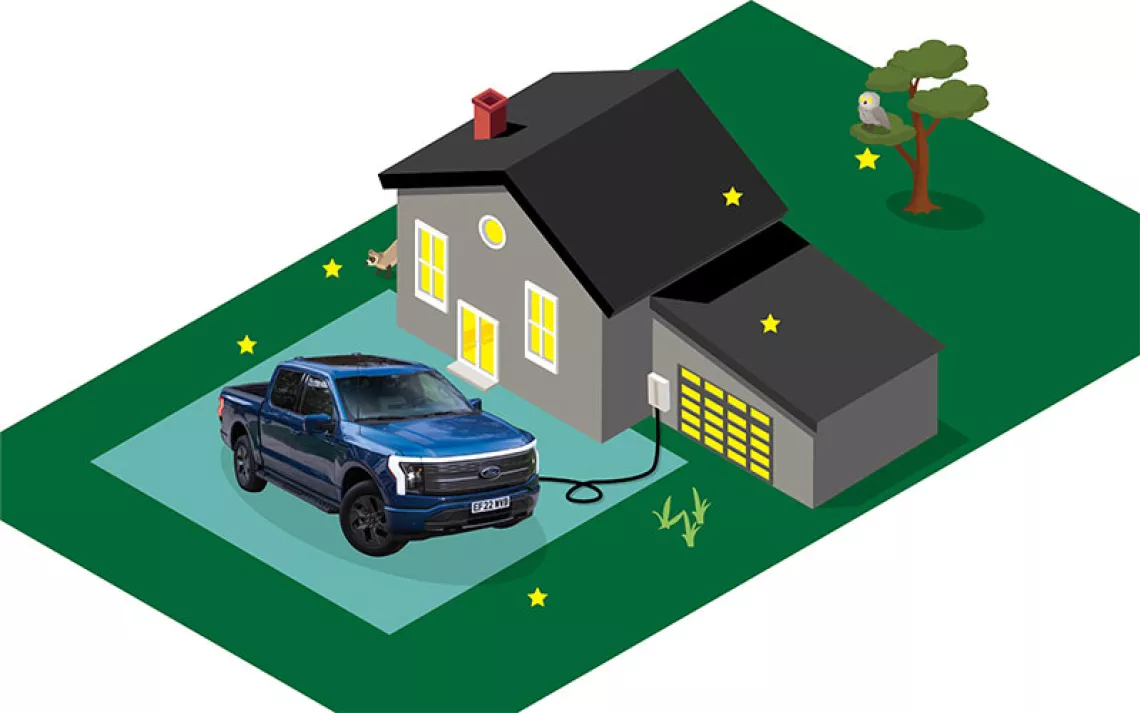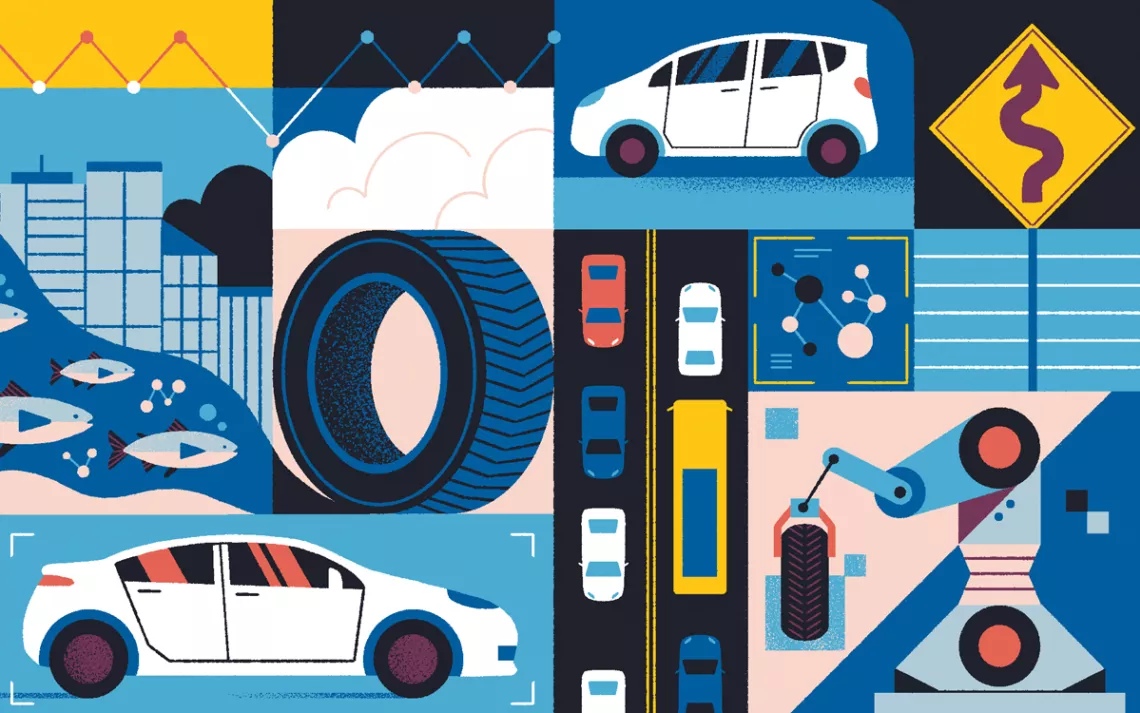The New Federal Climate Legislation Will Accelerate the Adoption of Electric Vehicles
Here’s what the IRA means for the transportation sector

Treasury Secretary Janet L. Yellen tours the Ford Rouge Electric Vehicle Center in Dearborn, Michigan, on September 8. | Photo by AP Photo/Paul Sancya
Inventors have been tinkering with electric vehicles in some form since the late 1800s. At that time, innovators around the world developed EVs in fits and starts—first came the battery, then the battery-powered carriage, then the small-scale electric car. By the turn of the last century, EVs were enjoying a surge in popularity. Had that momentum continued, it’s possible that transportation wouldn’t make up the largest share of greenhouse gas emissions in the United States today. But, of course, that’s not how the story went.
The newly passed Inflation Reduction Act can’t rewrite history, but it will change our course going forward. The law marks the largest investment of federal money ever for the electric vehicle industry. The act attempts an ambitious, two-pronged strategy of helping Americans become less reliant on fossil fuels by incentivizing EV purchases while insulating the US auto industry from geopolitical shocks by encouraging more domestic production.
“What's exciting about this legislation is that it’s going to work hand in hand with investments made over past years,” says Britt Carmon, the federal clean vehicles and fuels senior advocate at the Natural Resources Defense Council.
In 2009, as a response to the meltdown of the financial and real estate markets, Congress passed the American Recovery and Reinvestment Act, an economic stimulus package that included a credit to spur the adoption of EVs and hybrid cars. That legislation offered a $7,500 tax credit on new electric vehicles. But it also included a phase-out period that capped manufacturers from offering the incentive after they’d sold 20,000 vehicles. As of this writing, Tesla, GM, and Toyota have all hit that cap.
The Inflation Reduction Act extends the $7,500 tax credit through 2032, and it eliminates the manufacturing cap. At its most basic level, this is what it means: More money for more electric cars.
The new law also includes a new provision: A $4,000 credit for used electric vehicles. According to the Bureau of Transportation Statistics, Americans are three times more likely to buy a used car over a new car, so this provision will provide a real jolt to the secondary market for electric vehicles.
The $4,000 incentive for used EVs is accompanied by new income thresholds and MSRP caps for EV buyers. To qualify for the new vehicle credit, the manufacturer’s suggested retail price (MSRP) must be below $55,000 for sedans and below $80,000 for SUVs, trucks, and vans. For used vehicles, the price cap is $25,000. The tax credit is unavailable to buyers whose modified adjusted gross income is above $150,000 ($300,000 for married couples who file jointly; $225,000 for individuals who file as head of household).
In short, Congress targeted the EV incentives at middle-income consumers. “There is a finite amount of money,” says Katherine García, director of the Sierra Club’s Clean Transportation for All campaign. “You want to be able to stretch the funding so that it really goes toward folks that it will make a difference for, on whether they decide to buy an electric vehicle or not.”
Beyond targeting consumer cars, the act also allocates money for electrifying commercial fleets and ports.
A billion dollars is allocated to help companies replace their existing dirty heavy-duty vehicles with electric vehicles. Fleet owners will be eligible for a credit amounting to 30 percent of the sales price of the vehicle. The credit is capped at $7,500 for smaller-size vehicles and $40,000 for larger vehicles.
Another $3 billion will go toward electrifying the mail trucks of the US Postal Service: $1.29 billion for purchasing zero-emission delivery vehicles and $1.71 billion for the purchase, design, and installation of EV infrastructure. “USPS is really primed for electrification,” García says. “They travel short distances. They park at a central location every night. It's a commonsense vehicle to electrify.”
Domestic ports will receive $3 billion in funding from the Inflation Reduction Act, which port authorities can access by applying for grants to replace older, diesel trucks and equipment with zero-emission fleets. This funding will be layered on top of the grants already in progress thanks to funding from the bipartisan Infrastructure Investment and Jobs Act, which allocated $2.5 billion in grant funding ($450 million per year over five years) to port transitions.
Incentivizing the purchase of EVs is only part of the new law’s aim. It also seeks to lessen reliance on foreign-produced EV materials and to create more domestic jobs in the EV industry. To this end, the IRA contains a whole new set of ambitious—and at times confusing—manufacturing qualifications. These can be divided between final assembly and material sourcing.
The final assembly regulation is the more straightforward piece: As of the bill’s passage on August 16, 2022, final assembly of the vehicle must take place in North America. This whittled the available, qualified inventory down to 31 EV models.
Material sourcing, on the other hand, works on a graduated scale to phase out reliance on foreign supply chains and phase in domestically sourced and produced batteries. These materials are divided into battery components and critical minerals.
Half of a battery’s components must be manufactured or assembled in North America. That percentage requirement climbs by 10 percent most every year until 2029 (the requirement remains constant in 2024 and 2025). The sourcing of critical minerals follows a similar pattern but plateaus at 80 percent in 2027 and remains constant until the bill’s expiration in 2032. Additionally, by 2025 absolutely zero critical minerals can be sourced from any country labeled as an “entity of concern”—which includes China and Russia, both of which are significant sources of the minerals used in the clean energy economy. Both the components and critical mineral requirements go into effect at the start of 2023.
Some commentators have expressed skepticism around the new regulations, and this skepticism extends to the automakers themselves. If the whole point is to drive sales and transition into an EV-dominant auto industry, these voices argue, then enacting these difficult regulations could further throttle back supply, inflate prices, and stymie demand.
It’s true that, in the short term at least, the new requirements do create more friction in the EV market, as consumers scramble to figure out if, and when, they will be able to buy an EV and with which credit. In the long run, however, the new rules are likely to be a huge gain for middle-income consumers who want to purchase EVs. And they will also be a boon for auto manufacturers who will be able to rely less heavily on foreign imports.
“These are huge investments in this sector,” NRDC’s Carmon says. "So these regulations are for making sure that the investments being made into this space are actually staying in the country, that people are able to benefit, and that the money creates domestic jobs.”
The greater risk inherent in the clean energy transition is the potential threats that new mining and manufacturing plants might pose to vulnerable communities. Mining lithium—the main component of EV batteries—can take up a huge amount of space and have severe environmental impacts, including groundwater pollution and destroying wildlife habitat. The same can be said for battery-manufacturing facilities. While we should advocate for shorter supply chains and more domestic production, we should also be extremely wary and conscious of which communities are going to be affected by newly opened mines and manufacturing facilities.
As Jordan Brinn writes in an NRDC blog post about battery components, “97% of nickel, 89% of copper, 79% of lithium, and 68% of cobalt reserves in the US lie within 35 miles of Native American reservations.” Both Carmon and García emphasized the importance of updating current mining laws to protect both the land near mines and the communities surrounding it. “We must meet the demand for critical minerals in the most sustainable way,” García says, “but we want to make sure we are extremely careful we're not exploiting the land in a way that’s reminiscent of the fossil fuel era.”
For all of their benefits, the IRA’s transportation provisions involve a glaring omission: There’s little money for getting people out of their cars in the first place. An early draft of the act included a $3 billion tax credit to help consumers offset up to 30 percent of the cost of an electric bicycle (e-bike). A 2018 study by the Department of Energy showed that nearly 60 percent of car trips are less than six miles. Three-quarters of one-way car trips are less than 10 miles. In Colorado, pilot programs that distribute e-bikes and track user behavior have shown that they are effective car substitutes for local transportation. Across the country, cities are working to promote and distribute bikes as a viable method of transportation, especially among neighborhoods with poor access to transportation. So while the act does include $3 billion in neighborhood access and equity grants (which can be used for building bike infrastructure), for now it’s still up to local groups to push for more bike access, and more bikes.
*
For many people, all of this boils down to a single question: Should you buy an EV? The answer depends on how far along you are in the process. As Jim Tankersley succinctly put it in The New York Times, “If you’re a well-paid lawyer eyeing an electric Rivian sport-utility vehicle, you might want to buy it before New Year’s Day. If you’re a middle-class nurse saving up for a compact Chevrolet Bolt, you might want to wait until January.”
In the short term, there is going to be an even tighter restriction on supply amid an already surging demand. The two main reasons are new manufacturing regulations and the MSRP cap. A significant portion of current models on the market do not meet the sourcing and manufacturing standards that will be phased in beginning next year.
Furthermore, with the $55,000 to $80,000 MSRP cap, the highest-end EVs, such as Teslas, which do meet most of the manufacturing requirements, will be ineligible.
So, if you don't have an EV secured, then it's probably wise to wait for things to smooth out. The credits remain in effect until 2032, so even if it takes another two or three years for automakers to align themselves with the new requirements, consumers are still left with the better half of a decade to make their purchase. And who knows what advancements in technology and manufacturing will be made by then.
 The Magazine of The Sierra Club
The Magazine of The Sierra Club



